|
WHERE ARE THE GREAT SAGES OF ART?
REFLECTIONS ON THE ART OF TODAY
ESSAY - FICTION
JORDI RODRÍGUEZ-AMAT
In the queue of the Center Georges Pompidou in Paris to buy the ticket on the first Sunday of October 2010, 11 am. Exhibition: Arman.
- Who is this one?
I hear someone saying, right behind me, referring to a poster in front of us: Arman.
There is always a queue in the Center Pompidou. In Paris, in all museums, in all exhibitions, there are always queues. Today the National Museum of Modern Art is free, not this one.
Why are there so many people if it's not free? Whether it's free or not, there are always people here. People want to know. They want to know. They think that if they know, they will be better, happier. They run to where they think they will find something that will help them to know more. They want to know as much as those sages who know a lot about art. I am also here because I want to know about art, but what is art? What a question? Many times, I think about what art is.
Only the considered great artists are invited to exhibit in this center, those that are accepted as the superstars of contemporary art, the headlights that illuminate the so-called contemporary aesthetic or, better yet, the contemporary artistic conceptuality.
Once inside the exhibition, after having, obviously, paid for my ticket, I see that there are all kind of visitors. There is one a little stunned watching the exhibited works as if he was discovering something from another galaxy. There is also another one that seems to know everything. There's also the neophyte who says he doesn't understand anything. I am also there. Another one, without being a sage of art, seems to have his own idea of art and states that this is not art.
Suddenly, I hear a very beautiful young girl saying:
- is this art?
This is a question of the unbeliever, would say a sage of art.
- But don't you see that it’s being presented as an art exhibition in this important center for contemporary art?
Answered a young man who seems to be very much in love with her.
I go from one room to another, looking right and left. Title of the work? Of course, although we see it, the artist titled his works, for the case that someone couldn’t see it. Colère de Mandoline (a crushed and destroyed mandolin), Poubelle des Halles (all kinds of debris inside a glass box), Tuez-les tous, Dieu reconnaîtra les siens (thirty ancient fly-sprayers). Accumulation of machines à écrire dans une boîte en bois. I think again that I don't know why he puts a title if we can see it. Butterfly Variations (a violin carved and butterfly-shaped on a wooden board). I liked this one: Le Fauteuil d’Ulysse (a half-burnt armchair).
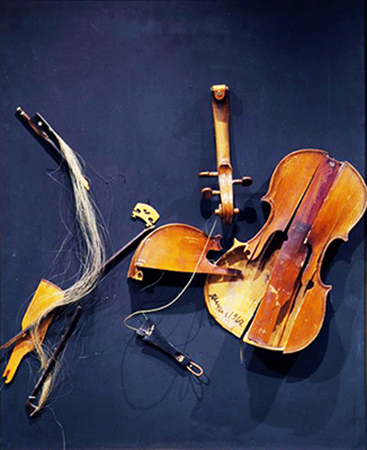
Colère de mandolie
|
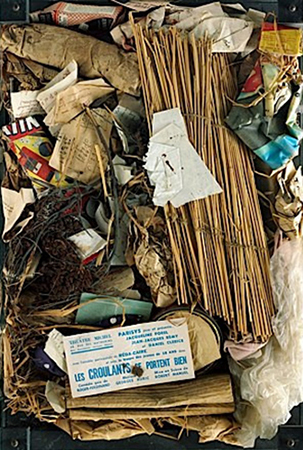
Poubelles des Halles
|
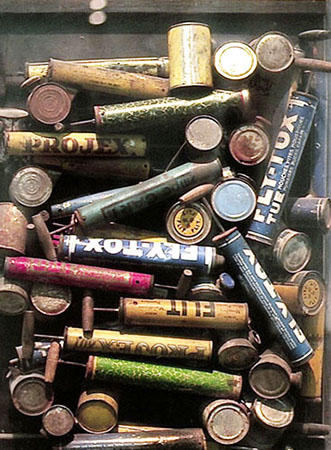
Tuez-les tous
|
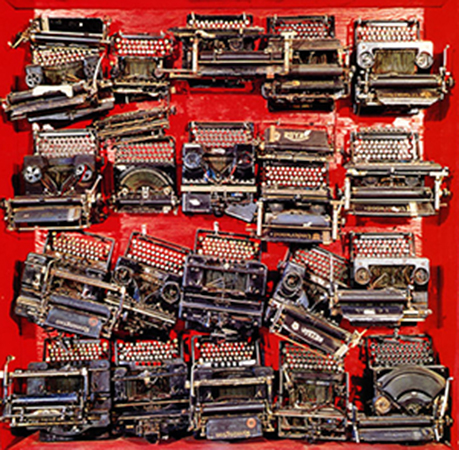
Machines à écrire |
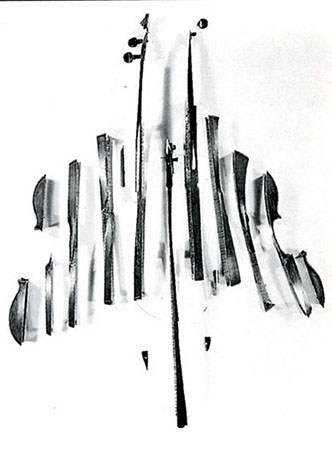
Butterfly variations |
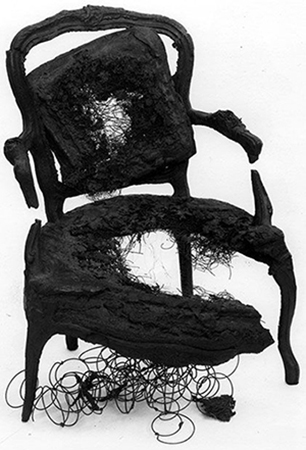
La fauteil d?Ulysse |
A little tired of reading so many titles .... Goodness me! what beautiful legs! In spite of not being a young girl, she wants to show her impressive body today. She looks like she is between forty and forty-five years old. Perfect! She knows how to move, stylish, shoes with high heels, a short skirt, a little above the knee. I doubt whether to look at the lady or the works displayed in the exhibition.
Here the mind cannot be passive and I wonder, what would happen if this same exhibition were presented elsewhere without the glamor of the Pompidou and under an unknown artist name? What reactions would the visitor have? Most of them, myself for instance, wouldn’t have come. What would this exhibition have been in a space without prestige? And the sage who says he understands so much? He would only enter to see the exhibition if he had accidentally passed by and had time for such banality. Anyway, he would say: this is art.
My desire to understand all this forced me, after having visited the entire exhibition, to go back to start over and see everything again, thus, slowly trying to reflect deeply.
- Today, there are those who talk about aesthetics without knowing exactly what it is. What does Kant say about aesthetics? Have they read it? And Hegel? And all the 20th and 21st century scholars who understand a lot of art? Surely, they haven't read it. This one says something that the other denies. And what he says is called into question by everyone else. This dialectic, believe me, is what gives meaning to many aspects of contemporary art.
All this was said by a lady who was seating next to me when, after discovering a bench to sit on, I aesthetically placed my ass on it and so I could rest from the artistic effervescences of that place.
- Have you heard of psychological aesthetics? And of phenomenological aesthetics? And of analytical aesthetics? Said the lady to a man who was seating by her side.
All these reflections on art and specifically on aesthetics are certainly complex.
And the good lady went on to say:
- There are those who talk about American analytical aesthetics, and cosmetic surgery and evacuation aesthetics.
Ah! sorry, I did not hear good, she said: evaluative aesthetics
- In addition, we find a lot of expressions such as aesthetic attitude, theory of aesthetics, aesthetics of the existence, aesthetics of perception, of appreciation, aesthetic regime, aesthetic experience, aesthetics of the times of the triumph of aesthetics. Do you follow me?
She continued asking to the man seating next to her and, with pompous pride, her cheeks swelled of knowing so much on aesthetics. I was already completely lost, but I must confess that for a moment I believed that the lady understood a lot.
| |
The consciousness of the individual, in conjunction with the artistic environment, forces us to reflect on the knowledge that art experts manifest without any clairvoyance and often confusion. On the other hand, art is not a science and cannot be accessed by cognitive reasoning that will allow the reflective individual to come out of the doubt that he or she can constantly be presented, especially when the hesitancy about relative truth takes over. Art is a versatile activity today, the knowledge of which becomes volatile due to the heterogeneity of many of its formulations.
The knowledge of the so-called contemporary art is shaped by many reflections, studies and readings. The artist himself, unsure of the path to follow, often becomes a pasture of doubt until, finally, he manages to achieve conceptual stability in the artistic way he has decided to pursue. From that moment on the artist himself conforms as an absolute truth the style, line or concept of the artistic principles he has decided to follow.
We know that any work, artistic or not, as well as any object can be contemplated and appreciated from an aesthetic point of view. What varies in these assessments are simply the views of the viewers. And it is these same points of view that determine appreciations that may be very different from one to another. They can even become quite the opposite.
|
We three, the man, the lady and myself, made a sandwich. She was the ham. After making profound reflections, this gentleman, bourgeois tie, said:
- Art is in decline today!
These two, let's call them spectators, were talking and talking and I, stunned, listened to them.
- You see the simple destruction of a violin.
Continued saying the man.
There was one smashed on a wooden board, under glass and with a frame.
- It is presented as a work of art!
A few meters from where we were seating, submerged in a kind of resin, detritus that the artist had gone searching for in a damp.
- Don't think art is in decline.
She resumed.
I wanted to believe that she was the one who understood a lot of art, although I don't think she was one of those wise people who understands it so much.
-The mere destruction of an object or the accumulation of debris inside a box can never be considered a work of art.
The lord answered. And he continued:
- You told me about aesthetics. What kind of aesthetic do you find here? Aesthetics is a part of philosophy that is about beauty.
The lady, her hair very short, answered again:
- Aesthetics must be accepted in its many appreciations, definitions and interpretations.
And the man, shaking his head, answered:
- But if aesthetics is a part of the philosophy that has to be logical, what logical sense can all this have? Logic is part of the philosophy that studies the laws of reasoning among others, and there is absolutely nothing logical here.
- Think that today's art, what we call contemporary art, is based on values and concepts that cannot be contemplated under the same parameters that are used to value art from other centuries.
The lady answered.
- On the other hand, I know there are those who say that another name would have to be found to designate the concept of contemporary art, simply because of the de-similarity with any of the definitions we can make of art from other historical times.
- Art, today, is not a philosophy, it is not a science, nor is it a religion.
- It's nothing.
Mr. interrupted.
- Shut up and let me talk.
The good woman replied.
- Contemporary art.
She continued.
- It is an activity of the human being that did not exist before.
The good man who seemed to have his head on his shoulders replies:
- Those who belief in contemporary art want that the social masses, follow them. Sorry, I meant a social minority, with illogical reflections that, under the same absurdity and relativity, they want to elevate to new forms of human actions.
- My friend.
She answered.
- The world is not static and, on the contrary, it is constantly evolving and revolutionizing, and the artist cannot stay away from this world. That is why the creator must be a revolutionary.
The gentleman, who was on the other side of the lady in reference to me, spoke loudly and so I could understand him without having to make any auditory effort. Of course, I didn't look at them, pretended to be absent, or they could stop their conversation.
- What you and few others like you call contemporary art is a fuck up. I'll tell you.
It was the gentleman who spoke now.
- Before and now, anyone who is engaged in any human activity must constantly make efforts of study and prepare to gain access to know it, and all that we see here does not require any efforts to do it. This man that you call an artist, does not need any effort to access a professional preparation that allows him to create what you call works of art and all he does is devote himself to such nonsense.
The lady who was not very pretty, but had put blue around her eyes, answered.
- What you say is not art, it also requires effort from the creator. The simple idea of breaking and destroying everything is enough to show that it requires a certain personal mental state, which allows access to new forms of human actions through great effort.
And the lady, very cheerful, continued.
- You know that everything is relative, that there is nothing absolute. Even the very existence of human beings is relative. In addition, there is nothing static and the fact of thinking itself is constantly evolving. You say that contemporary art is not art, that all this is absurd. Why don't you accept that even the absurd can be accepted as art and thus also reach artistic values? Even the aesthetics I talked about before are relative. Art, today, destroys established principles and does so voluntarily, consciously. You said that it is only the heritage of a minority, which I totally agree with, but one day it will be a mass culture. The logic of the illogical and the assessment of the absurd elevated to a work of art. And this is art because it has been the artists themselves who have evolved these new forms of the human spirit. If we look at the evolution of the art of the last century, the twentieth century, we will see how everything has evolved continuously. Each artist has made new contributions, they had new ideas to achieve what we are seeing here. And, moreover, this is art because the artist says it is. Art is what the artist says “This is art” and, my dear, that’s all.
I, despite making a lot of effort to continue the conversation, was already losing myself. I also thought that I could be one of those sages just to try to understand the whole conversation. The thing is, I didn't create anything new, I just wanted to understand what those two people were talking about. At one point, I thought that with so many reflections, the two of them could be tired, but the energy and the faith they put in their conversation was very great and they felt brave.
They stopped for a few seconds and I took the opportunity to look at the lady's legs. Even though I had her on my right side next to me, looking from the corner of my eyes, I could see that she put her skirt rising above her knee. Powerful thighs, I thought. Little by little, the lady seemed to be exalted. Her faith was so great that when she spoke, her cheeks turned red.
- It seems that you don’t know anything at all.
She resumed.
- Mental structures, freedom of spirit, imagination, among many other values, are elements that allow us to create new forms of human actions and contemporary art is one of them. You have to think that liberating yourself from the forms you call art is a manifestation of that freedom. And the artist has been and is a breakthrough in his time.
| |
Bigotry in non-scientific knowledge can annihilate the individual's reflective ability. Religious, nationalist and / or political fanaticisms are clear examples of this. Art, from the moment that the artist was considered to be a human being with certain differences to the vast majority of people, and the fact that his works were created under certain inspirations, has generated incessant discussions throughout the last two centuries. Recall the constant debates in the early nineteenth century between the proponents of romantic and that of neoclassical painting, or, in the late nineteenth century, between painters called pompiers and the impressionists. It is not necessary to add that throughout the twentieth century controversy has been a constant pasture, and this is no longer only between the artists themselves, but also among those people who were somehow interested in art. Some, anchored in established principles considered immutable by themselves, others, willing to break those principles, have generated a dialectic in which each of them think to be right. There are two very different formulations: for one art is immutable, while for others, art is like the same life and, consequently, it is constantly evolving. In any science of the spirit there is no absolute truth and the relative knowledge of each individual becomes the path and guide of his reasoning.
Proponents of contemporary art movements need to change the way they see and appreciate art. Others, with a high degree of skepticism, state that eternal principles are the only ones that should structure art. Under these discrepancies, it must be accepted that there is an inalienable right of the individual to uphold his principles, whatever their nature may be.
Despite this relativity, it must be stated that today the criteria for appreciation of so-called contemporary art cannot be based on pure, merely aesthetic principles. The fact that we cannot value it with the same criteria that we were used previously, we need to have, constantly, to use the contemporary adjective to specify what we are talking about. Some, even contemporary art proponents, say it should take another name. However, the fact that evolution has its origins in art, in particular modern art, and that the artists themselves have been the producers of such evolution, has made it impossible not to use the word contemporary. There are also those who object the possibility of changing the name because they consider that the great differences of conceptual principles between the arts of different eras are so great or even more so than those that occur today. The only difference is that the pace of its evolution today has been extremely accelerated. In the same way we see that in recent history, at the beginning of the 20th century, art had to take the modern term to be able to elucidate the differences with respect to any previous art. Let's take a general study book of the history of art and see that the principles, aims, aesthetics, etc. are absolutely disparate.
It seems as if the story between evolutionists and conservatives in the field of art is constantly being repeated. There are examples of this in every century. Think of Vasari, as far back as the sixteenth century, he referred to the art of the thirteenth, fourteenth, and fifteenth centuries with the term Gothic, which was synonymous with barbarism. And even today, discussions of no more than thirty or forty years resonate between modern art defenders and their detractors. Some, figurative art, against abstraction art, while, others, just the contrary.
|
Let me confess that before entering the exhibition, I had already bought the catalog and I put my ass on a chair on the terrace of the Pompidou center with a black coffee, served from a very beautiful mulatto girl, I read it. In Paris, you know, there are a lot of black and mulatto people. I thought the author of the presentation of that catalog knew a lot of art. I bought the catalog, of course, because I wanted to know about art myself. I felt like an owl with my eyes wide open and my mind wide awake to understand what the catalog said. It should be noted that there were two catalogs. One very thick with all the reproductions of, let's say, the works of the exhibition. I bought the cheapest and this was not because of the price that was less than the other, but because I thought that to begin to understand, it would already be good for me.
In addition, when I went to see the exhibition, I read the writings on the walls next to the works. Those writings, always manipulative, described how the works of this artist were made with debris that he had gone to collect in different places; bottles, all kinds of plastics, dirty papers, cans, pieces of clothing and many other things were in wooden or plexiglass boxes. I wanted to begin to understand it, but as I had said, contemporary art should not be understood.
| |
Regardless of the particular characteristics of each historical moment, the image has been subjected, for many centuries, to the imperative of visual description and narration. Many times, the narrative itself has become the meaning of the work and has shown the subjective reality of the moment. Even from a contemporary point of view, society can be considered to have been historically repressive with art, constantly demanding narration and description.
The possibility of the existence of an art without narrative has allowed at certain moments of the twentieth century to devise relatively free image discourses with respect to a descriptive image. This has generated a great number of aesthetic doctrines on which some artists have been able to base their work. This fact has led many creators to rush to destroy the representation of the object, and has originated a dialectic of the image between the visual narrative and certain values independent of the narrative itself. So, for many artists, storytelling is a pure and simple anecdote that must be destroyed. For others, however, they are values that take center stage within the work.
The bustle of artistic movements that have taken shape this last century suggests that the artist has embarked on a frantic race in search of absolute truths. Even certain creative attitudes have a tendency to avoid artistic production for mere aesthetic purposes. Modernity, or rather, contemporaneity, thus becomes a decision, an attitude of the individual.
On the other hand, there is a strong predisposition to conceptualize, to theorize any principle that can at the same time be translated into simple artistic action. Each artist has a clear tendency to define his own work within certain parameters and to delineate his world to achieve a personal status and different from any other in his environment.
Openly admitting the plurality of principles and the globality of thoughts, art nowadays has the capacity to expand, guide and at the same time develop the consciousness of the individual.
|
With my reflections I was afraid for a moment of missing the conversation and sharpened my ear again.
Now, it was the gentleman who was speaking.
- Do you think this set of false teeth in that box can be considered art?
The lady, becoming angry, answered him.
- But I didn't tell you, you can't value these works the same way you would with any non-contemporary work?
I would not like to see that lady in my house cooking. Well, I don't think that lady cooked much. What a character! I thought, because the tone of her words was beginning to punch like needles. I do like cooking, I ruminated.
- These are new concepts, ways of doing actions that can be considered absurd, but the absurdity is, in itself, a work of art.
The gentleman scratched his neck. It seemed that something was poking around him.
- And so, what should be valued?
He asked.
- Nothing should be valued!
The lady replied a little angry. She stopped talking for a while, but her desire to let him know what it all was forced her to continue.
- Look, the ways and concepts on which this new form of action is based are completely relative and cannot be valued by your logic. It seems as if there is nothing but logic for you. You have to know that the artist is a breakthrough of his time.
The lady looked up and gasped. The gentleman, though not as much as the lady, was beginning to be angry too.
- Look at me and listen to me!
She resumed.
- You like Monet's painting, that exhibition we saw in the Grand Palais yesterday. Well, over a hundred years ago, people like you were saying exactly what you are saying now. I'll give you an example. Pregnant women were then told not to go to Impressionist artists' exhibitions because they would lose their child. They said that because they considered it scary. Do you believe me or not?
The lady said in a slightly angry tone.
For a moment I was scared that the lady would hit him. The man did not share the ideas of that lady. This seems to be always the case with those people who refuse to accept what is called contemporary art.
One more attempt to impose his judgment led him, in my opinion, to manifest himself on a series of half-burned objects. According to explanatory texts on the walls, the artist burned objects and, before consuming them completely, put them out.
The burning of the object was part of the destructive action in one of a series of exposed works.
The man with a certain touch of irony:
- He seems not to be a great artist, because he doesn’t finish his job and leaves the items half burned.
The lady, seeing the ironic tone of the man, shook her head in contempt, and did not answer.
| |
If we analyze the history of art, we will see that at all historical times, from the moment when a new form of expression has appeared, until it has been considered consolidated, there has been a time, more or less long, in which the creators have moved on without knowing exactly what they had being doing. It must also be said that for many historical moments the creator has not been considered as such. In other words, he has not been given the title of inspired or even divine. Today, after more than a century of constant innovations and changes at a breakneck pace in artistic concepts and new contributions, both plastic and, above all, conceptual, art seems not to need to fulfill a social, religious purpose or another. This has been the most important release that art has achieved since the time it was called modern art.
On the other hand, today we cannot see what is the course that contemporary art will follow, leave the end result of all these actions alone. If we think about each and every one of the artistic movements that have taken place during the 20th century, we will see that it has taken years before theorists, art critics, gallery owners, curators, museum directors and artists - we have left them last - have been able to mark the itinerary of their own theories and, at the same time, to get the viewer, through a process of training and awareness, to value the new artistic or simply conceptual proposals.
It should be kept in mind that all valuations will always be relative, and the artistic movements of the last century have already become part of history.
Do you think that Delacroix who in his day broke rules would understand something of today's art? With this example I would like to show the relativity of this art. Everything is valid, if we want it to be. And in order to be valid, the simple viewer must assume the valuation, always, I say, relative, of any new proposal.
Little by little, influenced by that conversation, I was beginning to think, after reflecting so much, that art was absurd. Well, but absurdity can be art, too, said the lady. The aesthetic of the absurd or the absurd of the aesthetic. Like a brave man I wanted to go farther and said to myself. Art, if it exists is art, and if it did not exist, then its non-existence would also be art. If we accept that absurdity makes sense, then it will cease to be absurd and therefore will no longer be art. Well, no, since ceasing to be can in itself be art. As you can see, influenced by the deep thoughts of the lady, I was starting to be on the same line. Beauty is not art, because if it were art it would not be beauty. Either it's beauty or it's art. Art is everything and everything is art. If art demands concepts it is art and if not it is also art. That is why art is always art. Everything that is logical or illogical is art, because of being logical it is art and because of being illogical it is also art, all that is absurd is also art, because by the fact of being absurd also it is art. Creating is art and ceasing to create is also art. If I say it's art, it's art. The lady had said that art is what the artist says is art. And if I feel like an artist and say this is art, don't hesitate: it's art. Speaking can be art and not speaking too. Art is what I call art, because I am also an artist now. As you can see, I was already in the Lady's orbit. I went even further, so that lady could be considered to be my apprentice.
|
It was a few seconds that I didn’t listen what those two were saying, but all at once, I saw that they had changed the subject of conversation. Now they were talking about the stages of success. Why was that artist there and why not another? Why are there commercial interests that determine whether this or that is the new beacon of art today? That, I thought, doesn't interest me much anymore. Also, I was already in orbit and I could make my way alone.
That artist practiced his performance. What a wonder! One video showed how, with an ax and large hammers, he destroyed a furnished space. It had been a performance in a gallery anywhere in the world. Don't ask me where. There you could see how everything was crumbling. What a wonder! Vandalism raised to the highest level of contemporary art creation. I could also be an artist I thought and why not better than that? Not today, because I am tired of so much hesitation, but tomorrow I will destroy the world and thus be the greatest artist in all of human history. God created and I destroy. The aesthetics of the destruction of the world. What a wonder! That artist could be considered my ancestor, my great teacher and I wanted to overcome him. All artists have always had parents and grandparents, and I am not talking about biological parents and grandparents, but those who have influenced them with their art.
And all at once, without losing a single moment, I continue with my hesitations: but if art needs the viewer to be art and I destroy the world, there will be no one left to be a spectator. Answer. From now on, art can be art without a spectator and that is so because I say it.
My art will be sublime. There will be no museums, no galleries, no artists, no spectators, no works created. Everything will be destroyed! What a wonder! What a great artist! And God, will God be there? I will destroy him. With the destruction of God, I will free human beings. I will also release them, because I will also destroy them. And I? I will destroy myself too. Nothing will be left. Nothing. What a wonder!
And will you be there?
Come on! What a question!
I'm great! or? |
|





